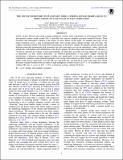| dc.contributor.author | Moriarty, John C | |
| dc.contributor.author | Ballard, Sarah A | |
| dc.date.accessioned | 2017-05-02T16:06:40Z | |
| dc.date.available | 2017-05-02T16:06:40Z | |
| dc.date.issued | 2016-11 | |
| dc.date.submitted | 2016-08 | |
| dc.identifier.issn | 1538-4357 | |
| dc.identifier.issn | 0004-637X | |
| dc.identifier.uri | http://hdl.handle.net/1721.1/108584 | |
| dc.description.abstract | NASA's Kepler Mission uncovered a wealth of planetary systems, many with planets on short-period orbits. These short-period systems reside around 50% of Sun-like stars and are similarly prevalent around M dwarfs. Their formation and subsequent evolution is the subject of active debate. In this paper, we simulate late-stage, in situ planet formation across a grid of planetesimal disks with varying surface density profiles and total mass. We compare simulation results with observable characteristics of the Kepler sample. We identify mixture models with different primordial planetesimal disk properties that self-consistently recover the multiplicity, radius, period and period ratio, and duration ratio distributions of the Kepler planets. We draw three main conclusions. (1) We favor a "frozen-in" narrative for systems of short-period planets, in which they are stable over long timescales, as opposed to metastable. (2) The "Kepler dichotomy," an observed phenomenon of the Kepler sample wherein the architectures of planetary systems appear to either vary significantly or have multiple modes, can naturally be explained by formation within planetesimal disks with varying surface density profiles. Finally, (3) we quantify the nature of the "Kepler dichotomy" for both GK stars and M dwarfs, and find that it varies with stellar type. While the mode of planet formation that accounts for high multiplicity systems occurs in 24% ± 7% of planetary systems orbiting GK stars, it occurs in 63% ± 16% of planetary systems orbiting M dwarfs. | en_US |
| dc.description.sponsorship | United States. National Aeronautics and Space Administration (NASA grant NNX12AC01G) | en_US |
| dc.description.sponsorship | Massachusetts Institute of Technology (Torres Fellowship for Exoplanet Research)) | en_US |
| dc.language.iso | en_US | |
| dc.publisher | Institute of Physics Publishing (IOP) | en_US |
| dc.relation.isversionof | http://dx.doi.org/10.3847/0004-637x/832/1/34 | en_US |
| dc.rights | Article is made available in accordance with the publisher's policy and may be subject to US copyright law. Please refer to the publisher's site for terms of use. | en_US |
| dc.source | American Astronomical Society | en_US |
| dc.title | THE KEPLER DICHOTOMY IN PLANETARY DISKS: LINKING KEPLER OBSERVABLES TO SIMULATIONS OF LATE-STAGE PLANET FORMATION | en_US |
| dc.type | Article | en_US |
| dc.identifier.citation | Moriarty, John, and Sarah Ballard. “THE KEPLER DICHOTOMY IN PLANETARY DISKS: LINKING KEPLER OBSERVABLES TO SIMULATIONS OF LATE-STAGE PLANET FORMATION.” The Astrophysical Journal 832, no. 1 (November 14, 2016): 34. © Copyright 2016 IOP Publishing. | en_US |
| dc.contributor.department | MIT Kavli Institute for Astrophysics and Space Research | en_US |
| dc.contributor.mitauthor | Moriarty, John C | |
| dc.contributor.mitauthor | Ballard, Sarah A | |
| dc.relation.journal | Astrophysical Journal | en_US |
| dc.eprint.version | Final published version | en_US |
| dc.type.uri | http://purl.org/eprint/type/JournalArticle | en_US |
| eprint.status | http://purl.org/eprint/status/PeerReviewed | en_US |
| dspace.orderedauthors | Moriarty, John; Ballard, Sarah | en_US |
| dspace.embargo.terms | N | en_US |
| mit.license | PUBLISHER_POLICY | en_US |
